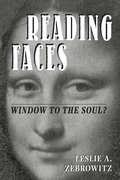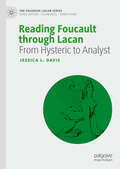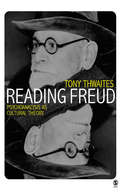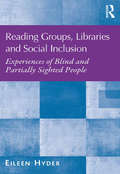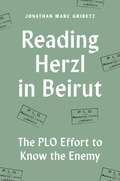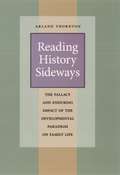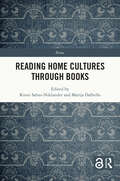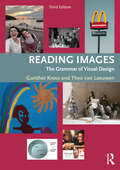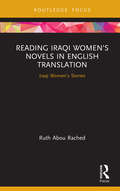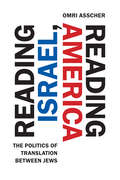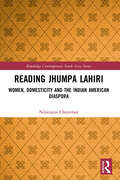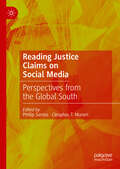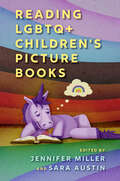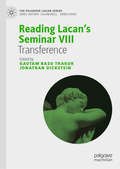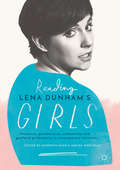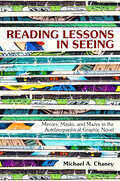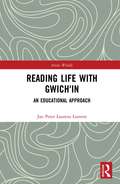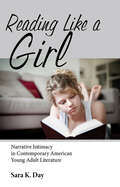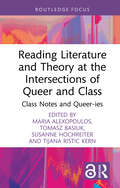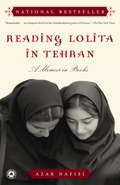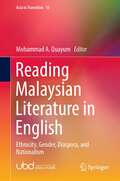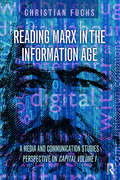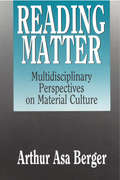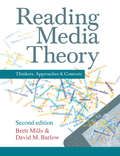- Table View
- List View
Reading Faces: Window To The Soul?
by Leslie ZebrowitzDo we read character in faces? What information do faces actually provide? Why do we associate certain facial qualities with particular character traits? What are the social and psychological consequences of reading character in faces? Zebrowitz unmasks the face and provides the first systematic, scientific account of our tendency to judge people by their appearance. Offering an in-depth analysis of two appearance qualities that influence our impressions of others, babyfaceness" and attractiveness",and an account of these impressions, Zebrowitz has written an accessible and valuable book for professionals and general readers alike.The assumption that people's faces provide a window to their inner nature has a long and distinguished history, eloquently expressed in the works of ancient philosophers, like Aristotle, and great writers, like Shakespeare. Zebrowitz examines this assumption, focusing on four central points. She shows that facial appearance, particularly babyfaceness and attractiveness, has a strong impact on how we perceive an individual's character traits and on social outcomes in the workplace, in the criminal justice system, and in other settings. She proposes that facial stereotypes derive from evolutionarily adaptive reactions to useful information that faces can provide. She assesses the accuracy of facial stereotypes in light of plausible links between appearance and character. Finally, Zebrowitz suggests ways to counteract the consequences of reading faces.
Reading Foucault Through Lacan: From Hysteric to Analyst (The Palgrave Lacan Series)
by Jessica L. DavisJacques Lacan and Michel Foucault are often cast as intellectual adversaries, their legacies marked by differences in method, lineages, and analytical priorities. Yet beneath their distinct projects lies a shared ambition: to decenter the Western conception of the subject while critically engaging with the notion of subjectivity in post-Kantian thought. This book examines Foucault’s critical project through the lens of Lacan’s theory of the four discourses, introduced in Seminar XVII: The Other Side of Psychoanalysis (1969-70). Divided into two parts, Reading Foucault through Lacan unfolds as a dialogue between the discourses of the Hysteric and the Analyst. Part I, “The Hysteric,” reframes Foucault’s genealogical critique from the early to mid-1970s as a form of hysterical questioning directed at Kant’s transcendental legacy and its aftermath. Through an exploration of how violence and embodied resistance interact in a discursive framework, Part I uncovers the epistemological fractures that mark the modern subject. Part II, “The Analyst,” examines Foucault’s redefinition of Kantian critique as a historically situated engagement with the present. Building on Lacan’s claim that analytic experience begins with the hystericization of discourse, this section views Foucault’s re-alignment with Kant as retroactively constituting the transformation from Hysteric to Analyst. Addressing themes such as parrhesia, transference, and the ethics of speaking, Part II examines discourse as a social link that transcends fixed identities to inhabit new modes of being. Drawing on newly available English translations of Foucault’s lectures and Lacan’s seminars, this book bridges two key trajectories in French thought and offers valuable insights for scholars of psychoanalysis, critical theory, and social philosophy.
Reading Freud: Psychoanalysis as Cultural Theory (Core Cultural Theorists series)
by Tony ThwaitesCultural theory has found a renewed interest in psychoanalysis, bringing many new readers to Freud and his work. This book is an introductory guide to Freud and brings together for the first time: an overview of Freud's work which enables the reader to see quickly where, and in which texts, Freud develops his main ideas a guide to reading Freud, and to what can be done with the complexities of his texts an examination of what recent cultural theory draws from Freud, and of why psychoanalysis is of interest for it a discussion about the Freud revealed by recent cultural theory an extensive selection of extracts from Freud's texts, with commentary. This book is the definitive guide to the content of Freud's texts: what's there and where to find it. It will have wide appeal to students new to Freud in cultural studies, literary theory, philosophy and sociology.
Reading Groups, Libraries and Social Inclusion: Experiences of Blind and Partially Sighted People
by Eileen HyderReading groups have grown rapidly in popularity and continue to be a significant cultural phenomenon. Reading groups in public libraries, linked to the learning and social inclusion agenda, have expanded to include a wide range of groups within society, including people with visual impairments (VIPs). This under-researched area is the focus of this book. Library-based VIP reading groups are interesting on many levels. Given that these groups predominantly use audio versions of the text (rather than print), this links to debates about the changing nature of reading in a multi-modal age. This book discusses whether contemporary society still defines reading as a visual activity or whether technological developments have led to a broadening of the definition of reading. The author goes on to discuss how policy is translated into practice within the library context and whether the wide range of reading groups linked to libraries suggests that libraries understand and are taking the social inclusion agenda seriously. She also explores how effectively libraries are using reading groups as a tool for delivering on the agenda for learning and how this sits within wider priorities for post-compulsory education and lifelong learning. Finally the book suggests ideas for future development for these groups, outlining ways in which their potential could be maximised for the benefit of both the library and the reading group members. The book will be of great interest to professional librarians as well as students and scholars of librarianship. It will also be of interest to those working on the emerging field of reading groups in literary studies. Those interested in the role of reading in education, as well as disability scholars, will also find the book useful.
Reading Herzl in Beirut: The PLO Effort to Know the Enemy
by Jonathan Marc GribetzHow the Palestine Liberation Organization Research Center informed the PLO&’s relationship to Zionism and IsraelIn September 1982, the Israeli military invaded West Beirut and Israel-allied Lebanese militiamen massacred Palestinians in the Sabra and Shatila refugee camps. Meanwhile, Israeli forces also raided the Palestine Liberation Organization Research Center and trucked its complete library to Israel. Palestinian activists and supporters protested loudly to international organizations and the Western press, claiming that the assault on the Center proved that the Israelis sought to destroy not merely Palestinian militants but Palestinian culture as well. The protests succeeded: in November 1983, Israel returned the library as part of a prisoner exchange. What was in that library?Much of the expansive collection the PLO amassed consisted of books about Judaism, Zionism, and Israel. In Reading Herzl in Beirut, Jonathan Marc Gribetz tells the story of the PLO Research Center from its establishment in 1965 until its ultimate expulsion from Lebanon in 1983. Gribetz explores why the PLO invested in research about the Jews, what its researchers learned about Judaism and Zionism, and how the knowledge they acquired informed the PLO&’s relationship to Israel.
Reading History Sideways: The Fallacy and Enduring Impact of the Developmental Paradigm on Family Life
by Arland ThorntonEuropean and American scholars from the eighteenth through the mid-twentieth centuries thought that all societies passed through the same developmental stages, from primitive to advanced. Implicit in this developmental paradigm—one that has affected generations of thought on societal development—was the assumption that one could "read history sideways. " That is, one could see what the earlier stages of a modern Western society looked like by examining contemporaneous so-called primitive societies in other parts of the world. In Reading History Sideways, leading family scholar Arland Thornton demonstrates how this approach, though long since discredited, has permeated Western ideas and values about the family. Further, its domination of social science for centuries caused the misinterpretation of Western trends in family structure, marriage, fertility, and parent-child relations. Revisiting the "developmental fallacy," Thornton here traces its central role in changes in the Western world, from marriage to gender roles to adolescent sexuality. Through public policies, aid programs, and colonialism, it continues to reshape families in non-Western societies as well.
Reading Home Cultures Through Books (Home)
by Kirsti Salmi-Niklander Marija DalbelloThis wide-ranging, comparative, and multidisciplinary collection addresses the significance of books in creating the idea of home. The chapters present cases that reveal the affective and sensory dimensions of books and reading in the practice of everyday life of individuals, in communities, and in society. The complex relationship of books, reading, and home is explored through American and European case studies both in bourgeois and middle-class homes, and in working-class and immigrant families and communities with limited possibilities for reading. The volume combines the conceptions and representations of domesticity, the materiality of reading, and library as a place, drawing on book history and material culture studies as well as anthropology and sociology of the home.
Reading Images: The Grammar of Visual Design
by Gunther Kress Theo van LeeuwenThis third edition of the landmark textbook Reading Images builds on its reputation as the first systematic and comprehensive account of the grammar of visual design. Drawing on an enormous range of examples from children's drawings to textbook illustrations, photo-journalism to fine art, as well as three-dimensional forms such as sculpture and toys, the authors examine the ways in which images communicate meaning. Features of this fully updated third edition include: new material on diagrams and data visualization a new approach to the theory of 'modality' a discussion of how images and their uses have changed since the first edition examples from a wide range of digital media including websites, social media, I-phone interfaces and computer games ideas on the future of visual communication. Reading Images presents a detailed outline of the 'grammar' of visual design and provides the reader with an invaluable 'tool-kit' for reading images in their contemporary multimodal settings. A must for students and scholars of communication, linguistics, design studies, media studies and the arts.
Reading Iraqi Women’s Novels in English Translation: Iraqi Women’s Stories (Focus on Global Gender and Sexuality)
by Ruth Abou RachedBy exploring how translation has shaped the literary contexts of six Iraqi woman writers, this book offers new insights into their translation pathways as part of their stories’ politics of meaning-making. The writers in focus are Samira Al-Mana, Daizy Al-Amir, Inaam Kachachi, Betool Khedairi, Alia Mamdouh and Hadiya Hussein, whose novels include themes of exile, war, occupation, class, rurality and storytelling as cultural survival. Using perspectives of feminist translation to examine how Iraqi women’s story-making has been mediated in English translation across differing times and locations, this book is the first to explore how Iraqi women’s literature calls for new theoretical engagements and why this literature often interrogates and diversifies many literary theories’ geopolitical scope. This book will be of great interest for researchers in Arabic literature, women’s literature, translation studies and women and gender studies.
Reading Israel, Reading America: The Politics of Translation between Jews (Stanford Studies in Jewish History and Culture)
by Omri AsscherAmerican and Israeli Jews have historically clashed over the contours of Jewish identity, and their experience of modern Jewish life has been radically different. As Philip Roth put it, they are the "heirs jointly of a drastically bifurcated legacy." But what happens when the encounter between American and Israeli Jewishness takes place in literary form—when Jewish American novels make aliyah, or when Israeli novels are imported for consumption by the diaspora? Reading Israel, Reading America explores the politics of translation as it shapes the understandings and misunderstandings of Israeli literature in the United States and American Jewish literature in Israel. Engaging in close readings of translations of iconic novels by the likes of Philip Roth, Saul Bellow, Bernard Malamud, Amos Oz, A. B. Yehoshua, and Yoram Kaniuk—in particular, the ideologically motivated omissions and additions in the translations, and the works' reception by reviewers and public intellectuals—Asscher decodes the literary encounter between Israeli and American Jews. These discrepancies demarcate an ongoing cultural dialogue around representations of violence, ethics, Zionism, diaspora, and the boundaries between Jews and non-Jews. Navigating the disputes between these "rival siblings" of the Jewish world, Asscher provocatively untangles the cultural relations between Israeli and American Jews.
Reading Jhumpa Lahiri: Women, Domesticity and the Indian American Diaspora (Routledge Contemporary South Asia Series)
by Nilanjana ChatterjeeThis book is an innovative and rigorous study of Jhumpa Lahiri's Indian American female characters' lived and imagined diasporic house space, using domesticity and the house as an analytical tool to explore their hidden domestic spaces. The book explores how the house as a spatial construct, shares a symbiotic relationship with its inhabitants, and through their implicit and explicit response to various parts of their diasporic house space, interprets their maladies, limitations and opportunities. Indian American diasporic women, especially homemakers, have long been grappling with issues of socio-cultural invisibility as they have no other space to interact with except their houses in the hostland, now more than ever, during the global corona crisis. A reading of this multi-layered relationship between houses and their women will help readers understand not only the political, intellectual, emotional and sexual dispositions of middleclass Indian women in America, but also social, cultural and economic positions they occupy within the hostland. The book shows the represented domestic interstices and looks at them as signifiers of distinct individual trajectories, wherein lies embedded the women inhabitants’ oppositions beneath the acceptance of normative Indian family values in diaspora. It also offers elemental insights into ways in which migration acts as an opportunity for establishing new, often hybridized, identities, for which it is important to realise their connections with their house space. Presenting an alternative methodology for reading real and imagined lives of women in Indian American diaspora, the book proposes an unconventional mode of understanding diasporic realities and representations in cultural studies that is not readily apparent. It will be of interest to researchers in the field of South Asian Studies, Diaspora Studies, Migration Studies, Culture Studies, Feminist Writings, Gender Studies and Asian Literature. Foreword by Bill Ashcroft
Reading Justice Claims on Social Media: Perspectives from the Global South
by Phillip Santos Cleophas T. MuneriThis book explores how unresolved questions of social justice shape the character of the political terrain and political actors, through the lens of social media. It treats communication as the medium through which social issues and processes are made visible. Given the rise and spread of populist politics, the views of ordinary people on social issues have never mattered more. One platform through which these voices can be studied extensively is social media. Platforms such as Facebook, Twitter now X, YouTube, and Instagram, among others, afford ordinary citizens—often marginalized by traditional mainstream media—space to vent their opinions, engage in discussions of whatever topic, share information and ideas, and explore various kinds of information as well as data, links to which are often provided through various macro and micro discursive spaces therein. Arguably, therefore, social media have become a quintessential platform for studying contemporary sociality. Social media mustbe studied not just as a communication platform, but one through which the social world, social processes and social issues are made visible and, in some cases, enacted. With rich case studies from the Global South, and a particular focus on Africa, this collection does just that.
Reading LGBTQ+ Children's Picture Books (Children's Literature Association Series)
by Jennifer Miller and Sara AustinContributions by Sara Austin, Rob Bittner, J. Bradley Blankenship, Gabriel Duckels, Caitlin Howlett, Isabel Millán, Jennifer Miller, Kaylee Jangula Mootz, Tim Morris, Dana Rudolph, j wallace skelton, Jason Vanfosson, River Vooris, and B. J. WoodsteinPicture books are books aimed at children where the illustrations are as important, or more important, than the text. Picture books, the effects of their simple text and importance in the literary canon, have been studied by scholars for decades, but little attention has been given to LGBTQ+ picture books. Reading LGBTQ+ Children’s Picture Books is a collection of essays that identifies and interprets children’s picture books that explicitly represent LGBTQ+ content.Contributors to the volume include established and emerging scholars with expertise in the fields of children’s literature, young adult literature, cultural studies, critical race and ethnic studies, gender and sexuality studies, history, and education. Each essay introduces readers to several children’s books that denote unmistakable LGBTQ+ content. Essays bring various interpretive frameworks and intellectual commitments to their unique readings of LGBTQ+ children’s picture books. The essays in Reading LGBTQ+ Children’s Picture Books produce innovative new scholarship about a range of topics including representations of LGBTQ+ marriage and parenting and LGBTQ+ history and culture. The topics explored, and theoretical frameworks applied, significantly expand available and accessible up-to-date scholarship on the growing field of LGBTQ+ children’s picture books.
Reading Lacan’s Seminar VIII: Transference (The Palgrave Lacan Series)
by Gautam Basu Thakur Jonathan DicksteinThis book provides 18 lively commentaries on Lacan’s Seminar VIII, Transference (1960-61) that explore its theoretical and philosophical consequences in the clinic, the classroom, and society. Including contributions from clinicians as well as scholars working in philosophy, literature, and culture studies, the commentaries presented here represent a wide-range of disciplinary perspectives on the concept of transference. Some chapters closely follow the structure of the seminar’s sessions, while others take up thematic concerns or related sessions such as the commentary on sessions 19 to 22 which deal with Lacan’s discussion of Claudel’s Coûfontaine trilogy. This book is not a compendium to Lacan’s seminar. Instead it attempts to capture through shorter contributions a spectrum of voices debating, deliberating, and learning with Lacan’s concept. In doing so it can be seen to engage with transference conceptually in a manner that matches the spirit of Lacan’s seminar itself.The book will provide an invaluable new resource for Lacan scholars working across the fields of psychoanalytic theory, clinical psychology, philosophy and cultural studies.
Reading Lena Dunham’s Girls
by Imelda Whelehan Meredith NashIn this book, leading and emerging scholars consider the mixed critical responses to Lena Dunham's TV series Girls and reflect on its significance to contemporary debates about postfeminist popular cultures in a post-recession context. The series features both familiar and innovative depictions of young women and men in contemporary America that invite comparisons with Sex and the City. It aims for a refreshed, authentic expression of postfeminist femininity that eschews the glamour and aspirational fantasies spawned by its predecessor. This volume reviews the contemporary scholarship on Girls, from its representation of post-millennial gender politics to depictions of the messiness and imperfections of sex, embodiment, and social interactions. Topics covered include Dunham's privileged role as author/auteur/actor, sexuality, body consciousness, millennial gender identities, the politics of representation, neoliberalism, and post-recession society. This book provides diverse and provocative critical responses to the show and to wider social and media contexts, and contributes to a new generation of feminist scholarship with a powerful concluding reflection from Rosalind Gill. It will appeal to those interested in feminist theory, identity politics, popular culture, and media.
Reading Lessons in Seeing: Mirrors, Masks, and Mazes in the Autobiographical Graphic Novel
by Michael A. ChaneyLiterary scholar Michael A. Chaney examines graphic novels to illustrate that in form and function they inform readers on how they ought to be read. His arguments result in an innovative analysis of the various knowledges that comics produce and the methods artists and writers employ to convey them. Theoretically eclectic, this study attends to the lessons taught by both the form and content of today's most celebrated graphic novels.Chaney analyzes the embedded lessons in comics and graphic novels through the form's central tropes: the iconic child storyteller and the inherent childishness of comics in American culture; the use of mirrors and masks as ciphers of the unconscious; embedded puzzles and games in otherwise story-driven comic narratives; and the form's self-reflexive propensity for showing its work. Comics reveal the labor that goes into producing them, embedding lessons on how to read the "work" as a whole.Throughout, Chaney draws from a range of theoretical insights from psychoanalysis and semiotics to theories of reception and production from film studies, art history, and media studies. Some of the major texts examined include Marjane Satrapi's Persepolis; Chris Ware's Jimmy Corrigan: The Smartest Kid on Earth; Joe Sacco's Palestine; David B.'s Epileptic; Kyle Baker's Nat Turner; and many more. As Chaney's examples show, graphic novels teach us even as they create meaning in their infinite relay between words and pictures.
Reading Life with Gwich'in: An Educational Approach (Arctic Worlds)
by Jan Peter LooversThis book is based upon more than two years of ethnographic fieldwork and personal experiences with the Teetł’it Gwich’in community in northern Canada. The author provides insight into Gwich’in understandings of life as well as into historical and political processes that have taken place in the North. He outlines the development of an educational approach towards conducting ethnography and writing anthropological literature, starting with the premise ‘you have to live it’. The book focuses on ways of knowing and collaboration through learning and being taught by interlocutors. Building on the work of Tim Ingold, Loovers investigates the notion of reading life - land, water and weather as well as texts – and analyses the reading of texts as acts of conversations or correspondences.
Reading Like a Girl: Narrative Intimacy in Contemporary American Young Adult Literature (Children's Literature Association Series)
by Sara K. DayBy examining the novels of critically and commercially successful authors such as Sarah Dessen (Someone Like You), Stephenie Meyer (the Twilight series), and Laurie Halse Anderson (Speak), Reading Like a Girl: Narrative Intimacy in Contemporary American Young Adult Literature explores the use of narrative intimacy as a means of reflecting and reinforcing larger, often contradictory, cultural expectations regarding adolescent women, interpersonal relationships, and intimacy. Reading Like a Girl explains the construction of narrator-reader relationships in recent American novels written about adolescent women and marketed to adolescent women. Sara K. Day explains, though, that such levels of imagined friendship lead to contradictory cultural expectations for the young women so deeply obsessed with reading these novels. Day coins the term “narrative intimacy” to refer to the implicit relationship between narrator and reader that depends on an imaginary disclosure and trust between the story's narrator and the reader. Through critical examination, the inherent contradictions between this enclosed, imagined relationship and the real expectations for adolescent women's relations prove to be problematic. In many novels for young women, adolescent female narrators construct conceptions of the adolescent woman reader, constructions that allow the narrator to understand the reader as a confidant, a safe and appropriate location for disclosure. At the same time, such novels offer frequent warnings against the sort of unfettered confession the narrators perform. Friendships are marked as potential sites of betrayal and rejection. Romantic relationships are presented as inherently threatening to physical and emotional health. And so, the narrator turns to the reader for an ally who cannot judge. The reader, in turn, may come to depend upon narrative intimacy in order to vicariously explore her own understanding of human expression and bonds.
Reading Literature and Theory at the Intersections of Queer and Class: Class Notes and Queer-ies (Focus on Global Gender and Sexuality)
by Tomasz Basiuk Maria Alexopoulos Susanne Hochreiter Tijana Ristic KernReading Literature and Theory at the Intersections of Queer and Class focuses on the crossover of queer and class, examining a range of texts across languages and genres and spanning nearly a century.This collection of chapters considers the intersection of queer and class in relation to literary aesthetics, a locus in which the interaction between sexuality and class is rendered with lucidity. Each chapter puts forward class and its manifestations as central to queer analysis of literary and cultural texts in historical and contemporary contexts. The readings adopt Kimberlé Crenshaw’s intersectional paradigm by pointing to its activist as well as literary precedents and elaborations.These chapters emerged from a long-standing collaboration among three Central European universities whose faculty and graduate students established a joint queer literature and theory research seminar. They are supplemented by a roundtable discussion in which the contributing authors and their colleagues discuss how the concepts of queer and class in theory and (academic) practice have informed their current and previous work.Reading Literature and Theory at the Intersections of Queer and Class is intended for scholars in gender and queer studies.
Reading Lolita in Tehran
by Azar NafisiWe all have dreams--things we fantasize about doing and generally never get around to. This is the story of Azar Nafisi's dream and of the nightmare that made it come true.For two years before she left Iran in 1997, Nafisi gathered seven young women at her house every Thursday morning to read and discuss forbidden works of Western literature. They were all former students whom she had taught at university. Some came from conservative and religious families, others were progressive and secular; several had spent time in jail. They were shy and uncomfortable at first, unaccustomed to being asked to speak their minds, but soon they began to open up and to speak more freely, not only about the novels they were reading but also about themselves, their dreams and disappointments. Their stories intertwined with those they were reading--Pride and Prejudice, Washington Square, Daisy Miller and Lolita--their Lolita, as they imagined her in Tehran.Nafisi's account flashes back to the early days of the revolution, when she first started teaching at the University of Tehran amid the swirl of protests and demonstrations. In those frenetic days, the students took control of the university, expelled faculty members and purged the curriculum. When a radical Islamist in Nafisi's class questioned her decision to teach The Great Gatsby, which he saw as an immoral work that preached falsehoods of "the Great Satan," she decided to let him put Gatsby on trial and stood as the sole witness for the defense.Azar Nafisi's luminous tale offers a fascinating portrait of the Iran-Iraq war viewed from Tehran and gives us a rare glimpse, from the inside, of women's lives in revolutionary Iran. It is a work of great passion and poetic beauty, written with a startlingly original voice.From the Hardcover edition.
Reading Lolita in Tehran: A Memoir in Books
by Azar NafisiWe all have dreams--things we fantasize about doing and generally never get around to. This is the story of Azar Nafisi's dream and of the nightmare that made it come true. For two years before she left Iran in 1997, Nafisi gathered seven young women at her house every Thursday morning to read and discuss forbidden works of Western literature.
Reading Malaysian Literature in English: Ethnicity, Gender, Diaspora, and Nationalism (Asia in Transition #16)
by Mohammad A. QuayumThis book brings together fourteen articles by prominent critics of Malaysian Anglophone literature from five different countries: Australia, Italy, Malaysia, Singapore, and the US. It investigates the thematic and stylistic trends in the literary products of selected writers of the tradition in the genres of drama, fiction, and poetry, from its beginnings to the present, focusing mainly on the postcolonial themes of ethnicity, gender, diaspora, and nationalism, which are central to the creativity and imagination of these writers. The book explores the works of not just the established writers of the tradition but also those who have received little critical attention to date but who are equally gifted, such as Adibah Amin, Edward Dorall, Rehaman Rashid, and Huzir Suleiman. The chapters collectively address the challenges and achievements of writers in the English language in a country where English is widely used in daily life and yet marginalised in the creative domain to elevate the status of writings in the national language, i.e., Bahasa Malaysia. The book will demonstrate that in spite of such recurrent neglect of the medium, Malaysia has produced a number of outstanding writers in the language, who are comparable in creativity and craftsmanship to writers of other Anglophone traditions. The book will be of interest to readers and researchers of Malaysian literature, postcolonial literatures, minority literatures, gender studies, and Southeast Asian studies.
Reading Marx in the Information Age: A Media and Communication Studies Perspective on Capital Volume 1
by Christian FuchsRenowned Marxist scholar and critical media theorist Christian Fuchs provides a thorough, chapter-by-chapter introduction to Capital Volume 1 that assists readers in making sense of Karl Marx’s most important and groundbreaking work in the information age, exploring Marx’s key concepts through the lens of media and communication studies via contemporary phenomena like the Internet, digital labour, social media, the media industries, and digital class struggles. Through a range of international, current-day examples, Fuchs emphasises the continued importance of Marx and his work in a time when transnational media companies like Amazon, Google, and Facebook play an increasingly important role in global capitalism. Discussion questions and exercises at the end of each chapter help readers to further apply Marx’s work to a modern-day context.
Reading Matter: Multidisciplinary Perspectives on Material Culture
by Arthur Asa BergerTo be civilized involves, among other things, making, using, and buying objects. Although speculation on the significance of objects often tends to be casual, there are professionals--anthropologists, historians, semioticians, Marxists, sociologists, and psychologists--who analyze material culture in a systematic way and attempt to elicit from it reliable information about people, societies, and cultures. One reason that analyzing objects has been problematical for scholars is the lack of a sound methodology governing multidisciplinary research. Reading Matter addresses this problem by defining a comprehensive set of methodological approaches that can be used to analyze and interpret material culture and relate it to personality and society.Berger offers discussions of the main concepts found in semiotic, historical, anthropological, psychoanalytic, Marxist, and sociological analysis. He provides practical descriptions of the working methods of each discipline and demarcates their special areas of investigation. Berger's lively discussions include a wealth of illustrative examples that help to clarify the complex and often difficult theories that underlie interpretations of material culture. In the second part of his analysis, Berger uses these disciplines to investigate one subject--fashion and an important aspect of fashion, blue jeans, and what the author calls the denimization phenomenon. Here he shows how different methods of reading material culture end up with different perspectives on things--even when they are dealing with the same topic.The author's focus is on the material culture of post-literate societies and cultures, both contemporary and historical. This comparative approach enables the reader to trace the evolution of objects from past to present or to see how American artifacts spread to different cultures, acquiring a wholly new meaning in the process. Reading Matter is an important contribution to the study of popula
Reading Media Theory: Thinkers, Approaches and Contexts
by Brett Mills David M. BarlowWhat does the Frankfurt School have to say about the creative industries? Does the spread of Google prove we now live in an information society? How is Madonna an example of postmodernism? How new is new media? Does the power of Facebook mean we're all media makers now? This groundbreaking volume – part reader, part textbook - helps you to engage thoroughly with some of the major voices that have come to define the landscape of theory in media studies, from the public sphere to postmodernism, from mass communication theory to media effects, from production to reception and beyond. But much more than this, by providing assistance and questions directly alongside the readings, it crucially helps you develop the skills necessary to become a critical, informed and analytical reader. Each reading is supported on the facing page by author annotations which provide comments, dissect the arguments, explain key ideas and terminology, make references to other relevant material, and pose questions that emerge from the text. Key features: Opening chapters: ‘What is theory?’ and ‘What is reading?’ bring alive the importance of both as key parts of media scholarship Pre-reading: substantial Introductory sections set each text and its author in context and show the relevance of the reading to contemporary culture Post-reading: Reflection sections summarise each reading’s key points and suggests further areas to explore and think about 4 types of annotations help you engage with the reading – context, content, structure, and writing style …. as well as questions to provoke further thought Split into 4 sections – Reading theory, Key thinkers and schools, Approaches and Media Theory in context New to the second edition: New chapters on New Media, and Audiences as Producers Reading Media Theory will assist you in developing close-reading and analytic skills. It will also increase your ability to outline key theories and debates, assess different case studies critically, link theoretical approaches to a particular historical context, and to structure and present an argument. As such, it will be essential reading for undergraduate and postgraduate students of media studies, cultural studies, communication studies, the sociology of the media, popular culture and other related subjects.
